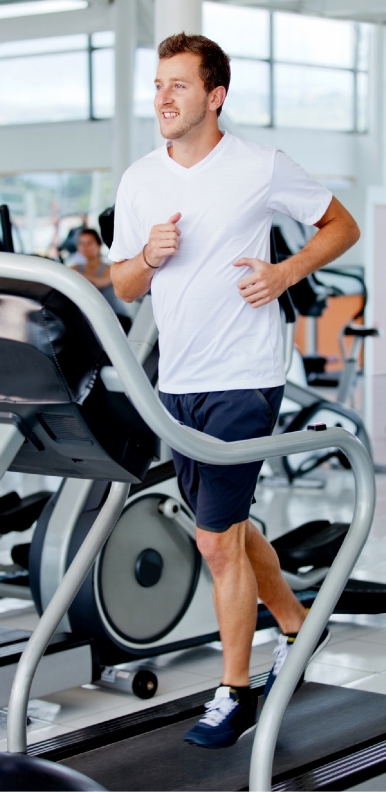Treadmill Training: Weighing the Pluses and Minuses
Running on a treadmill is safe and convenient, with almost all of the fitness advantages of running outdoors.

Over 40 million people use treadmills regularly in the United States. Their reasons range from losing weight to improving cardiovascular fitness and on up the spectrum to training for competitive distance running.
What, then, are the benefits of treadmill running versus outdoor running? Are we wasting our time when we pound away at a treadmill workout, or is this an effective method for gaining fitness and losing weight?
Advantages to Treadmill Running
The treadmill’s main benefit is that it lets us avoid running in extreme cold, strong winds and intense heat and humidity. We eliminate the possibility of slipping and falling on ice and snow, and our risk of heat exhaustion is greatly reduced. What’s more, slippery conditions interfere with normal running form and pace, so the treadmill offers a sound alternative.
Another important advantage is that treadmill running provides a flat, cushioned surface that is easier than outdoor terrain on the ankle, knee and hip joints. A treadmill is also great for those with orthopedic disabilities, such as arthritis and joint pain, and for obese or seriously overweight people.
Furthermore, the flat treadmill surface has none of the camber we find on the road, so treadmill runners have less chance of getting shin splints, Achilles tendonitis and knee injuries.
If your treadmill is nearby, you can run or walk whenever you want to, and you are always near a source of water, so dehydration is not a problem. Likewise, you’re always near a bathroom when nature calls.
Treadmill running lets you listen to music or watch TV/movies to prevent boredom—especially good for long runs. I have friends in Seattle who play motivating movies about distance runners while training on the treadmill: Running Brave, Fire on the Track, Chariots of Fire, Spirit of the Marathon and so on.
With treadmills, you can vary workouts by controlling speed and elevation. You can also do uphill workouts without any subsequent downhill run with its risk of muscle damage.
Disadvantages of Treadmill Running
Despite these benefits, walking and running outdoors offer some advantages over indoor treadmill running: exercising outdoors gets you out in the fresh air with changing scenery and offers different possibilities for training routes.
How does treadmill running compare with running outdoors on artificial (road, track) or natural surfaces? Many believe that running on the treadmill is not as challenging as outdoor running. The research here is interesting and noteworthy.
A study by McMiken & Daniels (1976) compared running at 180 meters per minute (m/min), 210 m/min and 260 m/min on a track and a treadmill. From a practical standpoint, there were no measureable differences in the oxygen costs of submaximal running in the two conditions. Likewise, Meyer et al. (2003) found that maximal oxygen uptake during field running did not exceed treadmill running oxygen consumption.
While running on the treadmill offers no wind resistance, Jones & Doust (1996) concluded that setting the treadmill elevation at 1% would compensate for energy loss from lack of air resistance.
However, as running speed picks up outdoors, wind resistance increases significantly, driving oxygen costs higher. Pugh (1971) showed that air resistance increases running workload between 2% and 10%, depending on the runner’s velocity and the headwind. Oxygen consumption while running at 15.9 kilometers per hour (km/hr) averaged 2.9 liters/minute (L/min) in calm conditions; rose to 3.09 L/min against a 16 km/hr headwind; and increased further to 4.1 L/min against a 66 km/hr wind (an additional 41% energy expenditure to maintain running velocity).
With treadmill running, deficiencies in energy expenditure can be remedied by setting the gradient at higher elevations.
Research has shown minor biomechanical differences between treadmill running and outdoor running. For experienced runners, treadmill running causes an increase in leg range of motion; thus, hip flexors stretch more than they do during outdoor running at comparable speed. Whether this represents a disadvantage remains to be seen, but it does indicate that distance runners should do a large portion of their training outdoors for best running economy. The general pattern of lower-limb angular kinematics is similar in overground and treadmill running (Donoghue & Harrison 2004).
Interestingly, Riley et al. (2000) found that treadmill running elicited a shorter stride length and more strides per minute in novice runners who switched from outdoor to treadmill running.
The treadmill surface is more cushioned than a road, which causes up to 10% less energy expenditure. This is because the “rebound,” or ground-reactive force, is softer on a treadmill, so our muscles don’t have to work as hard to spring us back after each footfall. However, for fitness buffs and people on weight loss programs, this represents no problem, as you can increase the treadmill elevation or simply work out longer to compensate for those “lost” calories.
Purchasing a Treadmill for Your Studio
Due to the heavy-duty use your treadmill will get, from clients of all weights and sizes, it is important to purchase a durable, commercial-grade machine. Treat the treadmill as a major purchase, and go to a reputable treadmill company, such as you would find at a fitness trade show. With good basic maintenance, your treadmill should last 7–12 years or longer.
The treadmill should be relatively quiet (making a “whirring” sound versus a loud “screaming” sound), sturdily built and able to take your weight (some treadmill warranties are void if you weigh more than the warranty states).
Look for a model built from aircraft aluminum and able to support a 500-pound load. The treadmill should not move around when you are running on it.
Be sure to get a feel for a treadmill before you purchase it. Try running on it, and then run or walk on it for 15–30 minutes. Most treadmills will feel good for the first 5 minutes, but after that your legs will discern a difference in better-quality models. Treadmill reps will typically arrange a tryout for you at a local fitness club that stocks their brand.
Purchase a machine with at least a 2.0 horsepower motor; that should be 2.0 “continuous horsepower” versus the “peak horsepower” available at full speed. Continuous-duty horsepower is a measure of sustained power during regular use. Your treadmill should be able to go at least 10 miles per hour (mph).
Get the largest belt width available for your model (18–24 inches) and length (45–60 inches). Ask for a four-ply belt—this will last the longest. You will likely have clients over 6 feet tall, so order the longest belt and deck possible (often called an extended belt). Make sure there is plenty of standing room beside your feet on the side of the belt. The deck should be at least 1 inch thick.
The deck should have adequate cushioning and “give”—you should not feel as though you were running on asphalt or cotton. Some treadmill brands advertise that their models reduce joint stress up to 30% compared with concrete or asphalt. Choose rubber padding versus foam.
Make sure the treadmill console is easy to read and use, and has good applications for your clients. Look for a calorie counter, a heart rate monitor, speed (miles per hour), an uphill and downhill gradient, a quick-start program and several custom programs. Make sure your treadmill has a red emergency shutoff button and a green “Quick Start” button. A nice add-on is a program that offers a fitness test so you can periodically evaluate your clients’ fitness.
Many personal trainers prefer treadmills with a database that stores workout information and that can even be used to program workouts.
Conclusions
Despite the differences in energy cost, biomechanical adjustments and lack of wind resistance compared with outdoor running, the treadmill remains an ideal exercise mode for general cardiovascular fitness or weight loss. It offers most of the advantages of outdoor running while providing a safer and more shock-resistant environment (thus less chance for injury) plus ready access to hydrating fluids. It is also easy to gauge and control the number of calories burned on the treadmill.
- Before clients run on your treadmill, familiarize them with the stop/start, speed incline/decline, quick start and program controls.
- Have clients straddle the sides of the belt when starting the machine. Do not let them stand on the belt, as this strains the motor and burns it out more quickly.
- Start them out slowly.
- Make sure they hold the side rails as they speed up or adjust the incline.
- For safety, have them bring the incline and speed down to normal before hitting the stop button (or they’re likely to go flying).
- Be sure they know where the emergency button is.
- Make sure clients use a fan on hot days to keep air circulating.
- Have clients warm up and cool down, as for any training run.
- Set the incline at a 1%–2% grade to compensate for lack of wind resistance.
- Be aware that when clients first run on a treadmill, they might feel a little unbalanced, as though they were going to pitch forward or slide off the back. They are learning a new motor skill, and it may take them a few workouts to feel fully comfortable on the treadmill.
- Encourage clients not to do all of their running training on the treadmill. They need more outdoor workouts than indoor treadmill workouts.
You can do long runs, tempo runs, speed runs, interval workouts and hill training on a treadmill, and all of these can be done walking, too. Most treadmills are wired in with the most common brands of heart rate monitors, making it easy to know when you are training within your heart rate zone.
The Workouts
Always warm up with a 10-minute jog, and do a cool-down jog for 5–10 minutes, gradually powering down to a walk. Fitness walkers should set the treadmill at a speed where they are breathing hard for the faster bursts, and then take it down to a slow walk for their recovery intervals.
Hill Workouts
If you live in a flat area where hills are hours away, a treadmill can help you adjust to uphill climbs.
1. Set grade to 2%. Run at your standard 10K pace for 2 minutes. Switch grade to 1%. Run at easy pace for 2 minutes. Then run 2 minutes at 3% followed by 2 minutes at 1%. Work your way up to 6% or 7%.
2. Set grade to 10%. Run at your standard 5K race pace for 1–2 minutes, concentrating on fast stride tempo and knee lift. Run 2 sets of 4 repeats.
3. Set grade to 5%. Run at 10K pace for 1 mile. Run 3 or 4 repeats.
4. Set grade at 3%. Run at 10K pace for 3 minutes, then jog easily for 3 minutes to recover. Run 3 or 4 repeats. Progressively increase number of repeats up to 10.
5. Set grade to 4%. Run for 5 minutes.
6. Set grade to 5%. Run for 10 minutes.
7. Set grade to 6%. Run for 10 minutes.
8. Set grade to 7%. Run for 10 minutes.
Note: To estimate your 10K pace, add 20 seconds per mile to your current best 5K race pace. To estimate your 5K pace, subtract 20 seconds per mile from your current best 10K race pace.
Tempo Running/Lactate Threshold Workout
1. Run 4–6 x 1 mile at lactate-threshold pace with 1- to 3-minute recovery jog in between.
2. Run at current best 10K race pace for 5 minutes and then jog easily for 5 minutes to recover. Repeat.
3. Set treadmill speed at 20 seconds per mile faster than your recent best 5K pace. Do 3 repeats of 3 minutes, with 3 minutes of very slow jogging between bursts.
4. Run 6 x 5-minutes with 1-minute rest between bursts.
5. Run 4 x 3 minutes with 2-minute rest bursts.
Interval Training
1. Run 6 x 2 minutes with 1-minute rest between bursts.
2. Run 6 x 60 seconds with 2- to 4-minute rest between bursts.
3. Run 10 x 60 seconds with 2- to 4-minute rest between bursts.
References
Donoaghue, O., & and Harrison, A.J. 2004. To examine the differences in rearfoot kinematics during treadmill and overground running. In M. Lamontagne, D. Robertson, & H. Sveistrup (Eds.), Proceedings of the 22nd IntInternational Symposium on Biomechanics in Sport, University of Ottawa.
Jones, A.M., & Doust, J.H.et al. 1996. A 1% treadmill grade most accurately reflects the energetic cost of outdoor running. Journal of Sports Sciences, 14 (4), 321-27.
McMiken, D.F., & Daniels, J.T. 1976. Aerobic requirements and maximum aerobic power in treadmill and track running. Medicine & Science in Sports & Exercise, 8 (1), 14-17.
Meyer, T., et al. & Welter, J. 2003. Maximal oxygen uptake during field running does not exceed that measured during treadmill exercise during running. European Journal of Applied Physiology, 88 (4-5), 387-89.
Pugh, L.G. 1971. The influence of wind resistance in running and walking and the mechanical efficiency of work against horizontal or vertical forces. Journal of Physiology, 213 (2), 255-76.
Riley, P., et al. 2008. A kinematics and kinetic comparison of overground and treadmill running. Medicine & Science in Sports & Exercise, 40 (6), 1093-1100.





